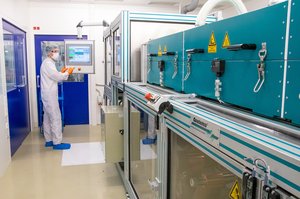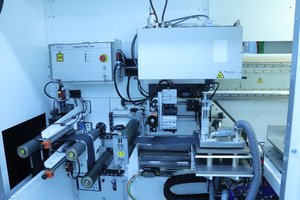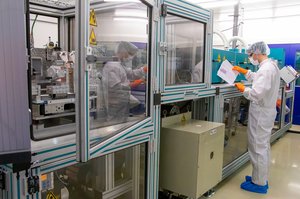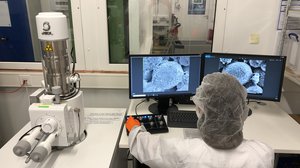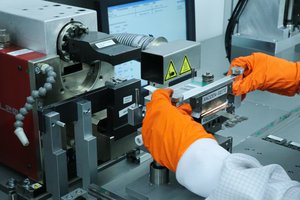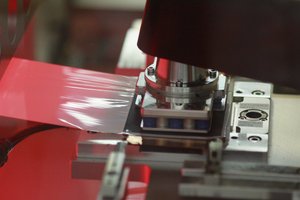Department Battery Production
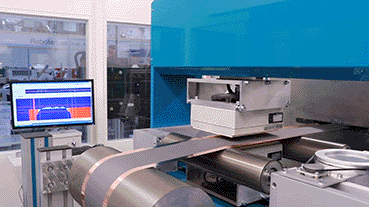
Powerful electrochemical energy storage systems are of great importance for applications in electromobility and stationary energy storage. Herefor, the improvement of gravimetric and volumetric energy density as well as the reduction of production costs are decisive. Only a deeper understanding of the processes involved in manufacturing LIB will enable producing improved and more cost-effective battery cells.
Therefore, the research activities of the Department Battery Production focus on the production of innovative battery cells. The core of the work is process development and the optimization of all processes within battery production. From mixing the electrode raw materials to the first charging and discharging cycles of the cells, all steps are carried out in-house at the iwb's research production line. Occupational safety is always in the foreground here. The iwb's industry-related research also ensures that the highest safety standards are maintained along the entire process chain. The cell portfolio comprises various cell types (coin cells, pouch cells, and hard case cells) with capacities ranging from a few mAh to over 20 Ah. For this purpose, iwb offers industry-oriented plant technology that can be flexibly adapted to the most diverse requirements.
In addition to the various materials of conventional lithium-ion batteries, the group also researches on solid-state batteries and the use of metallic lithium, as well as silicon composite anodes for the next-generation of lithium based battery technology.
Head of Department: Sophie Grabmann
Main research topics
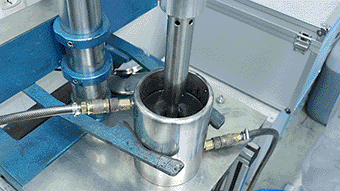
Electrode design and fabrication
The performance of battery cells depends not only on the materials used, but also on the composition and the structure of the electrodes. Each electrode material requires a new design of the manufacturing processes, which is why a deeper understanding of these is necessary. The processes considered within the research group range from powdered active material to the finished electrode and include mixing and dispersing, coating and drying as well as calendering and laser structuring of the electrodes.
In the research field of electrode design and fabrication, employees are working intensively on new electrode designs (from slurry formulations to electrode structures) and the processing of new electrode materials. On the cathode side, the focus of research is primarily on low-cobalt materials based on NMC and NCA as well as prelithiated manganese-rich high-voltage spinel. For anode materials, research focuses on silicon composites and the prelithiation of anodes.
In addition to materials research and research on electrode slurries, the iwb also deals with the design of electrode and cell designs. The focus here is on artificially generated electrode structures using mechanical structuring processes and laser structuring, as well as naturally generated structures using different porosities within the electrode layers.
Research Field Leader: Andreas Mayr
Cell production and quality
In cell assembly, functioning cells with high capacity and energy density are produced from individual electrodes. The later errors occur along the process chain, the greater the impact of rejects on costs, which is why quality assurance and process stability are of utmost importance for efficient production at high material costs.
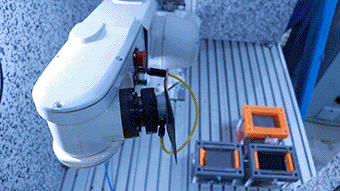
The research field cell production and quality is intensively concerned with cell assembly and the characterization of large-format battery cells. At iwb, research is carried out in the following process steps: electrode cutting (laser cutting and punching), automated stack formation, contacting, packaging, electrolyte filling, sealing and forming. The various influences of the individual process parameters on the finished battery cell are investigated in detail and the parameters are adapted specifically to the materials used and the requirements of the cell. In order to guarantee high productivity, good quality and low costs along the process chain, wb relies on innovative quality assurance methods and data-based process monitoring. Within the individual processes, various inline quality assurance measures ensure compliance with the required specifications. After each process step, the intermediate product also undergoes various quality controls before it is transferred to the next processing process. This ensures a constant, very high quality of the produced cells.
Research Field Leader: Alessandro Sommer
Coating system: Coatema BC 50
- Coating of battery electrodes on pilot plant scale
- Variable application tool: slot die and doctor blade
- Web speed: 0.1 - 2 m/min
- Maximum web width of 300 mm
- Infrared drying with three separately controllable drying segments
- Inert gas drying
- Quality monitoring: Lightwave sensor for thickness determination and ultrasonic measurement for surface loading determination
E-Cutter: Plant for cutting electrode sheets
- Fully automated system for separating anode and cathode rolls
- Contour cutting for continuously and intermittently coated electrodes
- Pulsed laser system for cutting process
- Format flexibility through 3-axis laser scanner
- Vacuum clamping device and particle extraction
- Automated material feed with web edge control
- 4-axis handling unit for removal of electrodes
Electrolyte filling system of Manz AG
- Partially automated system for introducing the electrolyte liquid into lithium-ion battery cells
- Vacuum and inert gas atmosphere to reduce the water content during electrolyte filling
- Format-flexible cell holders for large-format pouch and hardcase cells
- Precise metering of electrolyte quantity with gravimetric quality checks
- Additional mobile filling unit with overpressure and temperature control options for targeted process investigations
- Glovebox „Labmaster Pro SP“ with 4 gloves
- Working under controlled atmosphere with <1ppm oxygen and humidity
- Modular expandable glovebox system MB-MOD with 2 workstations
- Controllable vacuum furnace up to 250°C with parameter monitoring and temperature control unit
- ISO class 6 clean room (100 m²) for electrode production
- Coating line (web width up to 300 mm) with infrared drying and inline surface loading measurement
- Scanning Electron Microscopy (SEM): JEOL JSM-IT200 InTouchScope
- Fully equipped scanning electron microscope with tungsten cathode and integrated EDS analysis
- Highest image resolution in HV/LV/SE/BSE mode
- Zeromag mode for intuitive transition between light optical and SEM image
- Chemical analysis through integrated EDS with live analysis
- Numerous automatic functions and predefined recipes for different sample types
- Multi-channel live image and video recording possible simultaneously
- Fast sample navigation at 5x - 300,000x magnification
- Smile View Premium offline software with image sharpening, image montage, position alignment and superimposition
- Equipment for ultrasonic welding: contacting of electrode stacks
- Joining of uncoated electrode tabs
- Welding of arrester tabs
- contacting of single-layer as well as multilayer pouch or hard case cells
- Defined length of the electrode flags by integrated cutting device
- Particle extraction
- Semi-automated material feed with workpiece carrier system
- Z-Folders from Manz AG
- Automated Z-folder system for continuous stacking of large-format electrodes
- Shape-flexible tool inserts for stacking different electrode formats
- Possible use of different separator materials and widths
- Optical monitoring of positioning accuracy
- Control of separator position for precise stacking of electro
- Vacuum circulating air drying oven type HCV of the company Waldner Process Systems
- Drying of large-sized electrodes and coils under vacuum
- Variable adjustable drying times, temperatures and vacuum levels
- Traversing of drying profiles for uniform drying of the electrodes
- Two drying rooms (100 m²) for cell assembly
A variety of cell test systems are available for testing lithium-ion cells.
- BaSyTec CTS
- BaSyTec CTS LAB
- BaSyTex XCTS
- Biologic BCS-815
- Biologic VSP-3e
- Gamry Interface 5000E
Temperature chambers for testing:
- Vötsch VT 4021-S with safety equipment (-40 - 180 °C)
- Vötsch LabEvent T/210/40/3 with safety equipment (-40 - 180 °C)
- Vötsch TempEvent T/340/40/3 with safety equipment (-40 - 180 °C)
- Espec SU-242 (-40 - 150 °C)
- Binder ED-115 (20 - 300 °C)
